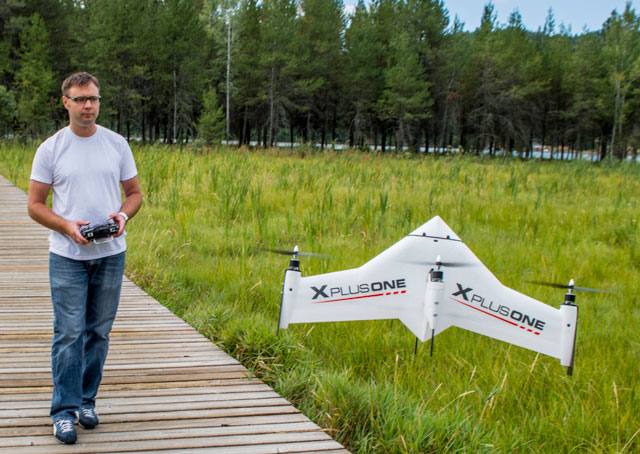
The painstaking, neck-craning, and otherwise difficult procedure for landing an airplane vertically on its tail relegated the Convair XFY-1 Pogo to a footnote in aviation history, but an Idaho designer’s unmanned version bears a striking resemblance to that footnote, and may grow into a manned aircraft of the future.
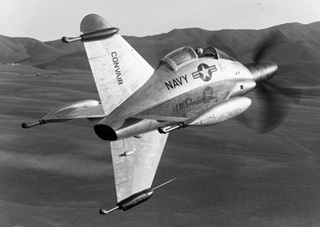
JD Claridge (he skips the periods that typically follow initials in the interest of easier typing) is a former electrical engineer for Quest Aircraft, a private pilot, an airframe-and-powerplant mechanic, and a bit of a dreamer. He sees a lot of potential in the vertical takeoff design that tips to horizontal for more efficient forward flight (with lift provided by wings) after clearing the ground on the lift of propellers alone. His unmanned version, X PlusOne, is hitting the market now, able to carry up to a pound of useful load at a forward speed up to 60 mph.
“You don’t have to think about keeping a human comfortable,” Claridge explained, recalling the thought process behind the design. “Let’s just tip the whole aircraft over and not worry about articulating arms. That does save a lot of weight, a lot of complexity.”
Claridge teamed up with Charles Manning, a technology executive, to create xCraft Enterprises, and turned to some thoroughly modern methods to raise investment capital. On Oct. 23, an episode of the ABC television show Shark Tank featured the duo and the X-wing design, along with another gadget that will turn a cell phone into a drone, giving it a protective case with four propellers attached. Their appearance on the show was taped in May, Claridge said, and they had to keep lips zipped tight until the episode aired. The result was a fresh influx of $1.5 million invested by the show’s five “sharks,” investors who famously grill inventors and entrepreneurs before an audience of about 10 million viewers.
Manning and Claridge had asked the sharks for $500,000 in exchange for 20 percent of the company, and wound up with triple that total, with 25 percent of the company divided among the five new investors. That, Claridge noted with a bit of pride, valued the entire company at $6 million before the first products shipped. A previous Kickstarter campaign had failed to meet its ambitious $250,000 crowd-funding goal to support the PhoneDrone, but after the show aired xCraft launched a new campaign on Kickstarter that topped the $100,000 goal in less than 48 hours. By Oct. 29, less than a week after millions got their first look at the phone drone and the X PlusOne, 718 backers had pledged $188,277.
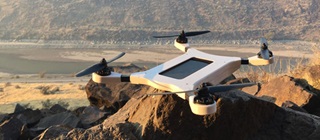
“We’ve received quite a few new orders now, after the airing,” Claridge said. xCraft is hiring people to fill those orders, and Claridge expects to expand from a staff of six to around 20 in the next couple of months, filling new jobs for product assembly, marketing, and other positions. Half of the money gleaned from the television investors will fund development of flying cell phones, which Claridge hopes to bring to market in September of 2016, and the other half will be used to build inventory of the X PlusOne and hire those new faces at the company’s base in Sandpoint, Idaho (not at all coincidentally the home of Quest Aircraft).
The PhoneDrone Ethos, as the upcoming model has been dubbed, takes advantage of the sophisticated sensors and computing power built into modern cell phones to control flight. The same hardware that allows a phone to change its display from horizontal to vertical when tilted or tipped has proved a solid base for an autopilot. The PhoneDrone, Claridge said, can fly on its own based on a preprogrammed route, or be controlled in the air by a second mobile device. It also will leverage cellular data network connections to steer clear of no-fly zones such as the temporary flight restrictions imposed during VIP movements and forest firefighting. The phone’s built-in camera can take pictures and video along the way, allowing skiers and kayakers to scout the route ahead, or golfers to get a peek over the hill to the next green, for example. Other limitations can be hard-coded for safety, Claridge said, such as the current limit of 400 feet agl for model aircraft (which may change as the FAA adopts a final rule for unmanned aircraft next year). Claridge’s company also has created an online registry for private property owners who wish to prohibit drone overflights. (This is one of a few similar efforts that Claridge expects will eventually coalesce into a single database protecting privacy in much the same way a no-call list provides relief from telemarketers.)
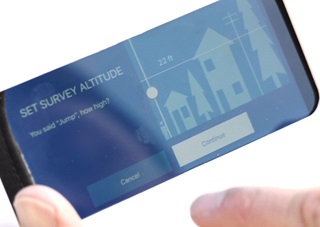
As for X PlusOne, which is shipping to early customers already with new orders expected to start shipping in November, the small aircraft with the XFY-1-esque design is bringing new capabilities in terms of speed (a top speed of 60 mph) and endurance (about 20 minutes) to the unmanned aircraft world. The speed, coupled with a sophisticated autopilot, allows X PlusOne to follow fast-moving targets (a motorcycle, for instance) and keep them in frame with a gimbal-mounted GoPro camera.
“We view the X PlusOne as the Tesla of drones,” Claridge said. It “does something that other drones don’t do.”
Being able to take off and land in tight quarters, then transition to high-speed horizontal flight, makes it an ideal platform for a variety of missions, from package delivery to powerline surveys, search and rescue, and aerial mapping.
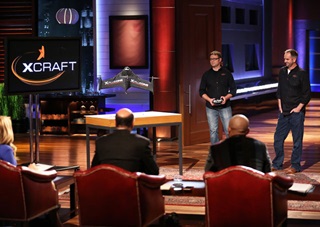
“All these uses can really use the ability for both vertical takeoff and landing and hover and also high speed” forward flight, Claridge said.
Patents already applied for envision the X PlusOne being scaled up to handle much larger payloads, including a manned version in which the cockpit would be mounted on a scaled-up gimbal similar to the gimbal that holds the camera steady on a fixed target as the aircraft moves around it. While the X PlusOne’s useful load is one pound, “we’ve actually lifted up to six pounds vertically with it,” Claridge said. At higher weights the wing loading is too high for efficient forward flight, but that’s just a matter of scale. The manned version of the future could be autonomous, flown by a human pilot, or some combination of those.
“Whatever the application is, that’s where we’ll be,” Claridge said. “We would size the airframe accordingly.”
Meanwhile, the X PlusOne has hit the market at prices ranging from $1,549 for a kit to $2,199 for a ready-to-fly version fitted with a Pixhawk autopilot designed by 3D Robotics. (GoPro cameras and the gimbal, which replaces the streamlined nose cone, are sold separately. The gimbal is priced at $379, or bundled with a GoPro Hero 4 Silver for $679.)



